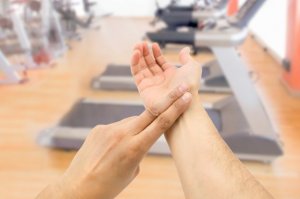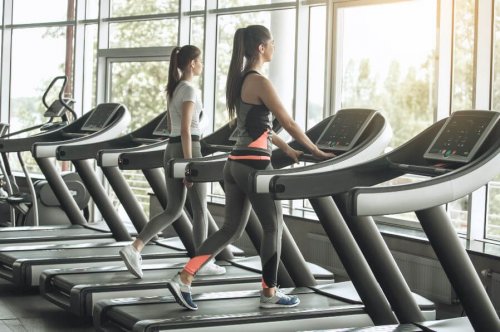How to Calculate Your Pulse While Doing Cardio

Exercising without control, records, and statistics is similar to walking blind. We could be doing too much or not enough. If we don’t meet our goals, nothing will change. Therefore, it’s essential to be aware of our pulse while doing cardio.
Undoubtedly, the only way to burn calories and exercise our cardiovascular system is by reaching our maximum heart rate. But what does this consist of? How can we calculate it?
At present, all of us who do sports can keep track of our pulse while doing cardio and set goals. There are devices, formulas, and other key factors that we’ll discuss next.
In search of the maximum pulse while doing cardio
This concept simply deals with the maximum number of beats that the heart can achieve in one minute. A limit of healthy functioning is established for this organ. The possibility of overcoming it and suffering some illness requires us to control that frequency.
When we do cardio exercises, our objective is to reach that maximum heart rate. Going beyond would put us at risk, just as not reaching it implies doing little or nothing. Burning calories accordingly depends on reaching that limit, which is demanding, yet healthy.
One of the biggest problems we have when exercising is not knowing our pulse measurement while doing cardio. This is equivalent to working out without counting the repetitions or the weight we lift in the gym. As we all know, data is essential to finding results.
Two formulas we can use to calculate pulse while doing cardio
Currently, smartphones can help us to measure our vital signs. However, if we don’t know how to use these applications, we can also use the display data on equipment such as ellipticals or bikes.
We can also appeal to the classic resource of placing the index and middle fingers on our wrist; at the base under the thumb or on the neck. Once this is done, we should count the beats in the space of one minute. With this information, it’s possible to apply certain formulas with pencil and paper.

There’s more than one formula, of course. The first one we’ll show you is Max. HR= 207 – 0.7 x age. Here, the only variable that will depend on us is our age. There are those who rely on this mathematical calculation, which is verifiable in training tests.
Another formula that lots of people use is Haskell and Fox. It’s like this: Max. HR = 220 – age. In reality, both formulas have their pros and cons. What’s effective is to personally try both and pick the best for each athlete.
A complex formula: heart rate reserve
A third method invites us to calculate the heart rate reserve first, so we can later know the maximum. To do this, we’ll apply the following formula: 220 – AGE – RHR = H.R. Res. RHR stands for resting heart rate. This measurement can be calculated with any pulse device.
After that, to obtain the maximum heart rate, we’ll use the following formula: (H.R. Res x % intensity) + RHR = Ideal HR. In regard to the intensity data, it’s what we need to burn calories.
We know that to lose weight and exercise at an aerobic level, our pulse should be between 60 and 80 percent. That’s what we’ll put here: the intensity percentage. After using the two formulas, we’ll have two results: together they define the range we must reach to burn fat.
Applications that measure your heart rate while doing cardio
We live in a time of superior technology and almost all of us have a smartphone. Some devices, such as those from Apple, have apps exclusively dedicated to measuring these indicators.

In regard to the Android operating system, we’ll definitely find multiple apps allowing us to calculate these vital signs. The fact is that, although we know how to calculate our maximum heart rate, the correct thing to do is to know how much we can endure when we exercise.
There are also websites online that are dedicated to the calculation of this frequency. It’s all a matter of doing a little research and exploration. A good idea would be to compare the results of some applications or devices to have a reference.
What about the resting heart rate?
This is also an important indicator. It’s thought that the lower the resting heart rate, the healthier we are. This information means that we’re in shape and it’s a good omen in the face of problems that cause tension.
In time, it’s logical for the resting heart rate to decrease, the more we exercise. Although, only healthy people with stable indicators must take all of this into account.
In the case of people with heart conditions, the right thing to do is to consult a doctor. This specialist will indicate how much exercise and effort you must perform to avoid any failure during your training.
Exercising without control, records, and statistics is similar to walking blind. We could be doing too much or not enough. If we don’t meet our goals, nothing will change. Therefore, it’s essential to be aware of our pulse while doing cardio.
Undoubtedly, the only way to burn calories and exercise our cardiovascular system is by reaching our maximum heart rate. But what does this consist of? How can we calculate it?
At present, all of us who do sports can keep track of our pulse while doing cardio and set goals. There are devices, formulas, and other key factors that we’ll discuss next.
In search of the maximum pulse while doing cardio
This concept simply deals with the maximum number of beats that the heart can achieve in one minute. A limit of healthy functioning is established for this organ. The possibility of overcoming it and suffering some illness requires us to control that frequency.
When we do cardio exercises, our objective is to reach that maximum heart rate. Going beyond would put us at risk, just as not reaching it implies doing little or nothing. Burning calories accordingly depends on reaching that limit, which is demanding, yet healthy.
One of the biggest problems we have when exercising is not knowing our pulse measurement while doing cardio. This is equivalent to working out without counting the repetitions or the weight we lift in the gym. As we all know, data is essential to finding results.
Two formulas we can use to calculate pulse while doing cardio
Currently, smartphones can help us to measure our vital signs. However, if we don’t know how to use these applications, we can also use the display data on equipment such as ellipticals or bikes.
We can also appeal to the classic resource of placing the index and middle fingers on our wrist; at the base under the thumb or on the neck. Once this is done, we should count the beats in the space of one minute. With this information, it’s possible to apply certain formulas with pencil and paper.

There’s more than one formula, of course. The first one we’ll show you is Max. HR= 207 – 0.7 x age. Here, the only variable that will depend on us is our age. There are those who rely on this mathematical calculation, which is verifiable in training tests.
Another formula that lots of people use is Haskell and Fox. It’s like this: Max. HR = 220 – age. In reality, both formulas have their pros and cons. What’s effective is to personally try both and pick the best for each athlete.
A complex formula: heart rate reserve
A third method invites us to calculate the heart rate reserve first, so we can later know the maximum. To do this, we’ll apply the following formula: 220 – AGE – RHR = H.R. Res. RHR stands for resting heart rate. This measurement can be calculated with any pulse device.
After that, to obtain the maximum heart rate, we’ll use the following formula: (H.R. Res x % intensity) + RHR = Ideal HR. In regard to the intensity data, it’s what we need to burn calories.
We know that to lose weight and exercise at an aerobic level, our pulse should be between 60 and 80 percent. That’s what we’ll put here: the intensity percentage. After using the two formulas, we’ll have two results: together they define the range we must reach to burn fat.
Applications that measure your heart rate while doing cardio
We live in a time of superior technology and almost all of us have a smartphone. Some devices, such as those from Apple, have apps exclusively dedicated to measuring these indicators.

In regard to the Android operating system, we’ll definitely find multiple apps allowing us to calculate these vital signs. The fact is that, although we know how to calculate our maximum heart rate, the correct thing to do is to know how much we can endure when we exercise.
There are also websites online that are dedicated to the calculation of this frequency. It’s all a matter of doing a little research and exploration. A good idea would be to compare the results of some applications or devices to have a reference.
What about the resting heart rate?
This is also an important indicator. It’s thought that the lower the resting heart rate, the healthier we are. This information means that we’re in shape and it’s a good omen in the face of problems that cause tension.
In time, it’s logical for the resting heart rate to decrease, the more we exercise. Although, only healthy people with stable indicators must take all of this into account.
In the case of people with heart conditions, the right thing to do is to consult a doctor. This specialist will indicate how much exercise and effort you must perform to avoid any failure during your training.
All cited sources were thoroughly reviewed by our team to ensure their quality, reliability, currency, and validity. The bibliography of this article was considered reliable and of academic or scientific accuracy.
- Roncancio, M. R., Malik, M., Singh, D., Saini, B. S., Kumar, V., SAYKRS, B. M., … Hongxing, L. (2014). Efecto del ejercicio en la variabilidad de la frecuencia cardíaca. Physica D: Nonlinear Phenomena, 20(1), 24–32. https://doi.org/10.1007/BFb0091924
- De La Figuera Von Wichmann, M., & Vinyoles Bargalló, E. (2011, January). Frecuencia cardíaca y riesgo cardiovascular. Hipertension y Riesgo Vascular. https://doi.org/10.1016/j.hipert.2010.10.003
- Ortigosa, J., Reigal, R. E., Carranque, G., & Hernández-Mendo, A. (2018). Variabilidad de la frecuencia cardíaca: Investigación y aplicaciones prácticas para el control de los procesos adaptativos en el deporte. Revista Iberoamericana de Psicologia Del Ejercicio y El Deporte, 13(1), 121–130. https://doi.org/10.2527/jas.2009-1980
This text is provided for informational purposes only and does not replace consultation with a professional. If in doubt, consult your specialist.








